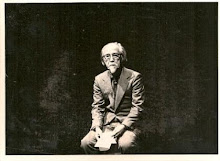_01.jpg)
The idea of the reporter as a purveyor of truth in a world populated with blind sheep was a popular image during the Great Depression. They unearthed the buried crimes of the rich and powerful, and created a podium for the disenfranchised to speak freely. Each Dawn I Die takes the reporter out of the newsroom and puts him smack in the middle of a news story.
James Cagney plays Frank Ross a zealous reporter who uncovers a graft scandal at the start of the movie and, to shut him up, gets framed for vehicular manslaughter. Ross believes in the justice system, and can't picture a country that would send innocent men into the bowels of Rocky Point Penitentiary. All throughout the picture he rails against corruption while never condemning the flawed system that put him in a jail cell. Even when the very system he is defending beats him down on a daily basis Ross stands firm in his belief that he will get out.
Audiences in the 1930's went to see this movie not for its social message though, but rather for the simple fact that it teamed up two stars, James Cagney and George Raft. Both were New Yorkers who went to the West Coast and made careers out of playing tough guy roles, and it must have been exciting to be a moviegoer then watching these two physically and verbally spar with each other on the big screen.
Inside the penitentiary, the story becomes a study of the male relationship, specifically between Ross and Raft's gangster character, Stacey. The bond between these two men is what keeps this movie from going stale. Ross and Stacey deal with prison life on their own terms yet one has to admire the fact that neither allows the inhuman treatment they get to devolve them into the animals that many of the inmates have become.
Ross is a newcomer to the penal system while Stacey is a product of it. Throughout most of the story Ross is quite passive even as he witnesses the guards abuse and brutalize the inmates. Audience's soon realize, just as Ross does, that the rules of the outside world have no meaning in prison. On the other hand, Stacey holds a lot of power inside the prison, but is completely distrustful of everybody and is caught off guard by Ross' friendship. Stacey finds in Ross "a square guy", and gives up his freedom to help his friend.
It's no surprise that in this prison movie the most flawed performance was Jane Bryan who plays Joyce Conover, Ross' girlfriend. She has very little to do but beg everybody around her to help Cagney's character. By the end of the movie we miss Raft's character more and really could care less of Ross and Joyce's reunion.
William Keighley was primarily known as an action director during his tenure at Warner Bros. but he always managed to direct the audience's attention towards social problems. This movie illustrated how the power of the political machine can manipulate people to lock up good citizens and that the penal system can just as easily create crooks as well as they can rehabilitate them.




No comments:
Post a Comment